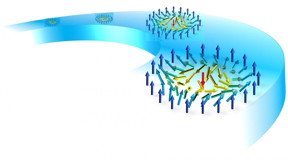Bit data goes anti-skyrmions
Today's world, rapidly changing because of "big data", is encapsulated in trillions of tiny magnetic objects - magnetic bits - each of which stores one bit of data in magnetic disk drives. A group of scientists from the Max Planck Institutes in Halle and Dresden have discovered a new kind of magnetic nano-object in a novel material that could serve as a magnetic bit with cloaking properties to make a magnetic disk drive with no moving parts - a Racetrack Memory - a reality in the near future.
Most digital data is stored in the cloud as magnetic bits within massive numbers of magnetic disk drives. Over the past several decades these magnetic bits have shrunk by many orders of magnitude, reaching limits where the boundaries of these magnetic regions can have special properties. In some special materials these boundaries - "magnetic domain walls" - can be described as being topological. What this means is that these walls can be thought of as having a special magical cloak - what is referred to by scientists as "topological protection". An important consequence is that such magnetic walls are more stable to perturbations than similar magnetic bits without topological protection that are formed in conventional magnetic materials. Thus, these "topological" magnetic objects could be especially useful for storing "1"s and "0"s, the basic elements of digital data.

These are anti-skyrmions on a racetrack.
One such object is a "magnetic skyrmion" which is a tiny magnetic region, perhaps tens to hundreds of atoms wide, separated from a surrounding magnetic region by a chiral domain wall. Until recently only one type of skyrmion has been found in which it is surrounded by a chiral domain wall that takes the same form in all directions. But there have been predictions of several other types of skyrmions that were not yet observed. Now in a paper published in Nature*, scientists from Prof. Stuart Parkin's NISE department at the Max Planck Institute for Microstructure Physics in Halle, Germany, have found a second class of skyrmions, what are called "anti-skyrmions", in materials synthesized in Prof. Claudia Felser's Solid State Chemistry Department at the Max Planck Institute for CPFS, Dresden, Germany. The scientists from Halle and Dresden have found these tiny magnetic objects in a special class of versatile magnetic compounds called Heusler compounds that Claudia Felser and her colleagues have explored extensively over the past 20 years. Of these Heusler compounds, a tiny subset have just the right crystal symmetry to allow for the possibility of forming anti-skyrmions but not skyrmions. Using a highly sensitive transmission electron microscope at the Max Planck Institute for Microstructure Physics, Halle, that was specially modified to allow for the detection of tiny magnetic moments, anti-skyrmions were created and detected over a wide range of temperatures and magnetic fields. Most importantly, anti-skyrmions, both in ordered arrays and as isolated objects, could be seen even at room temperature and in zero magnetic fields.
The special cloaking properties of skyrmions makes them of great interest for a radically new form of solid-state memory - the Racetrack Memory - that was proposed by Stuart Parkin a decade ago. In Racetrack Memory digital data is encoded within magnetic domain walls that are packed closely within nanoscopic magnetic wires. One of the unique features of Racetrack Memory, which is distinct from all other memories, is that the walls are moved around the nanowires themselves using recent discoveries in spin-orbitronics. Very short pulses of current move all the domain walls backwards and forwards along the nano-wires. The walls - the magnetic bits - can be read and written by devices incorporated directly into the nanowires themselves, thereby eliminating any mechanical parts. Topologically protected magnetic walls are very promising for Racetrack Memory.
Thus, anti-skyrmions could be coming to Racetrack Memory soon! Going even beyond anti-skyrmions the next goal is the realization of a third class of skyrmions - antiferromagnetic skyrmions - which are tiny magnetic objects that actually have no net magnetic moment. They are magnetically almost invisible but have unique properties that make them of great interest.
Source: Nanotechnology Now
- 458 reads
Human Rights
Ringing FOWPAL’s Peace Bell for the World:Nobel Peace Prize Laureates’ Visions and Actions

Protecting the World’s Cultural Diversity for a Sustainable Future

The Peace Bell Resonates at the 27th Eurasian Economic Summit

Declaration of World Day of the Power of Hope Endorsed by People in 158 Nations

Puppet Show I International Friendship Day 2020

